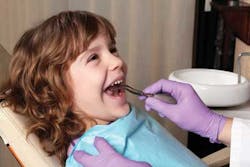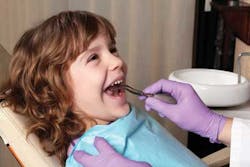Prescription and OTC meds and their side effects in children
BY CATHY HESTER SECKMAN, RDH
Several years ago, a mother came to our pediatric office with her 7-year-old son. When I asked about health changes, she said worriedly, "We have an appointment with the pediatrician tomorrow. I'm afraid Sean might have diabetes."
"Why is that?" I asked.
"He keeps saying he's thirsty. He asks for water 20 times a day. I can't think of any reason why he'd suddenly be so dry. Extreme thirst is a warning sign for diabetes, isn't it?"
"It is," I agreed, "and you should check it out. But there are other reasons he could be thirsty."
"What do you mean?"
The child's health history listed asthma.
"Does Sean still take asthma medications? Any new ones recently?"
"No, same one. He has one of those puffer things -- you know, the kind he puts in his mouth. He hardly ever needs it though. Oh, wait, he does use it more since we put him in soccer this summer."
It's easy to guess the end of this story. Sean did not have diabetes; he was just suffering from impaired salivary function because of the corticosteroids in his inhaler. He had also had a cold recently, and his mother had given him Children's Tylenol Cold Liquid, a side effect of which is dry mouth, nose, or throat.
Forty years ago, when I started in hygiene school, it was not common for children to be on prescription medication, but these days there are dozens of reasons a child might need drugs. There's asthma, of course, and diabetes; ADD/ADHD; autism and Asperger's; conduct disorders; anxiety and panic disorders; mental disorders such as depression, bipolarism, and schizophrenia; epilepsy and seizures; digestive disorders, including anorexia and bulimia; chronic infections; allergies; and acne and birth control for teens.
As if prescription medications and their side effects weren't enough to deal with, there are dozens of over-the-counter medications and supplements on the market that parents routinely give their children. Many of those also have side effects that can present in the mouth. Successful integration of a child's health history into dental hygiene treatment becomes more imperative every day.
Take the case of benzocaine, a common ingredient in OTC gels and liquids applied as pain relievers to the teeth and gums. Most dental offices probably keep sample packets of these products to hand out for teething and canker sore problems. Did you know benzocaine products should not be used for children under the age of 2? The U.S. Food and Drug Administration does not recommend using a benzocaine-containing product for a toddler's teething pain. It was the subject of an FDA alert last year.1 Benzocaine, in rare cases, can trigger a potentially lethal condition called methemoglobinemia, in which oxygen in the bloodstream is greatly reduced.
According to the FDA, methemoglobinemia has occurred mainly in children age 2 and younger who were treated with a benzocaine gel for teething. Symptoms include pale, gray, or blue-colored skin, lips, and nail beds; shortness of breath; fatigue; confusion; headache; lightheadedness; and rapid heart rate. Symptoms can occur within minutes of a first application, or after continued use.
The safest recommendations for teething pain are still the simple, nonpharmaceutical ones: finger massage or application of something cold, such as a washcloth kept in the refrigerator or a frozen teething ring.
Most side effects of prescription and nonprescription medications for children, thank goodness, are not life-threatening. But they still need to be addressed.
One possible side effect of drugs is enamel erosion. Chewable vitamin C tablets have been shown by researchers to cause erosion, exposure of dentin, and calcium release in bovine teeth after prolonged exposure.2 Another study looked at the effects of analgesics that contain citric acid. Researchers concluded that all but one of the analgesics studied caused statistically significant but clinically insignificant enamel erosion. An analgesic called Aspro, they said, needed further study.3
A better-known drug side effect is xerostomia, which we all know can have severe oral health consequences in children. Drugs known to contribute to dry mouth include acne medications, anorexiants, antianxiety and antidepressant medications, anticonvulsants, antihistamines, antiobesity medications, bronchodilators, and decongestants.4
In addition, many nonprescription medications a parent might give a child for a cold or allergies list dry mouth as a side effect. Drug Information Online provides a list of OTC children's medications and their side effects at http://www.drugs.com/sfx/children-s-side-effects.html.
Sometimes one medication can be substituted for another to eliminate the dry mouth side effect. Sean's mother, for example, had been giving him Children's Tylenol Cold Liquid. Depending on his symptoms, the next time he has a cold, she might be able to give him Children's Tylenol Plus Cough and Runny Nose Suspension, which does not list dry mouth as a side effect. Similarly, Nexium, given to children for GERD, can cause dry mouth, but Pepsid, also used for GERD, does not.
Because normal salivary function is a necessary part of the taste experience, xerostomia can be a factor in taste alteration. Dysgeusia, a taste abnormality associated with drugs including antianxiety agents, antidepressants, and antidiabetic agents, can cause an alteration or distortion of taste.5
A study published in the European Journal of Internal Medicine states that taste and smell are essential to a sense of well-being. Taste-related problems, the study found, can cause pain and discomfort and hinder a proper diet. Loss of taste can contribute to illness if nutrition is affected.6
When was the last time a child in your chair threw a fit because the prophy paste or fluoride "tastes yuk-kyyyy!"? When was the last time his mother asked, "Oh, can't you just skip that part? He doesn't like it."
Maybe the underlying problem is taste alteration from a medication the child is taking. If that's the case, you could try every flavor in your drawer and still not find an acceptable one. Instead, try Nada by Preventech, a flavor-free prophy paste; or one of Butler's paste-free prophy angles.
Prescription and OTC medications should be considered when trying to pin down a cause for taste alteration, xerostomia, erosion, or increased caries. If it isn't feasible for a child to switch medications or stop taking one altogether, the best things we can do are to recommend rinses following medication and suggest ways of alleviating dry mouth issues.
Tell parents to have the child rinse with water or a fluoride mouthwash after using any medication that might stay in the mouth, such as a sticky liquid or powder from an inhaler.7 Make sure children stay away from chewable medication whenever possible, and make sure sealants are applied.
Xerostomia can't be cured by drinking extra water, though the water can help. A hygienist who suffers from Sjögren's syndrome used this analogy once to explain it to me. "If your skin is dry, do you put more water on it? No, you treat the tissues first." That's why we need other weapons in our dry-mouth arsenal.
My favorite remedy for xerostomia is to add xylitol products to a child's diet, whether it's in gum, lozenges, stick-ons, toothpaste, or mouthwash.
The Dry Mouth Clinic at the Tufts School of Dental Medicine recommends using a Sonicare toothbrush; a prescription toothpaste such as Prevident; sugar-free gum or candy; MI Paste, Biotene, or similar dry-mouth products; prescription medication such as Evoxac or Salagen; and three-month recare appointments.8
Finding a method that works best for your patients is imperative to ensure that no medication, whether prescription or over-the-counter, contributes to oral health issues. RDH
CATHY HESTER SECKMAN, RDH, has written on dental topics for 26 years. She works in the pediatric office of Jay Reznik, DMD, MS.
References
1. U.S. Food and Drug Administration. Available at: http://www.fda.gov/drugs/drugsafety/ucm250024.htm accessed April 3, 2012
2. Meurman JH, Murtomaa H. Effect of effervescent vitamin C preparations on bovine teeth and on some clinical and salivary parameters in man. Scand J Dent Res. Dec. 1986; 94(6):491-499.
3. McNally LM, Barbour ME, O'Sullivan DJ, Jagger DC. An in vitro investigation of the effect of some analgesics on human enamel. J Oral Rehabil. Jul. 2006; 33(7)529-532.
4. D'Alessandro DM, D'Alessandro MP. Pediatric Digital Library and Learning Collaboratory. Available at http://www.pediatriceducation.org/2009/07/13/ Accessed April 3, 2012
5. Sharuga CR, Cluk D. A matter of taste. Dimensions of Dental Hygiene, March 2012; 60-63.
6. Naik BS, Shetty N, Maben EV. Drug-induced taste disorders. Eur J Intern Med. Jun. 2010; 21(3:240-3. Epub 2010 Feb 26.
7. Asthma and Allergy Foundation of America. Available at: http://www.aafa.org/display.cfm?id=8&sub=17&cont=167 Accessed April 3, 2012
8. Tufts University School of Dental Medicine. Available at: http://dental.tufts.edu/1176988224004/TUSDM-Page-dental2ws_1259850121244.html Accessed April 3, 2012
Websites for drug and supplement information
Besides the trusty office copy of the Drug Information Handbook, Internet-connected offices can make use of websites that offer drug and supplement information to professionals and consumers. Some are free; others require subscriptions. Many also offer apps that can be used with Blackberries, iPads, PDAs, etc.
- The U.S. Food and Drug Administration lists recent news, alerts, recalls, and general drug information here: http://www.fda.gov/Drugs/default.htm
- The American Academy of Allergy Asthma and Immunology offers a free drug guide at http://www.aaaai.org/conditions-and-treatments/drug-guide.aspx
- Davis's Drug Guide has a searchable drug database by subscription only. www.drugguide.com
- Drug Information Online allows health professionals and consumers to run free searches on drug side effects and interactions at www.drugs.com. An interesting page on the site lists the side effects of dozens of OTC pediatric cold, flu, and allergy medications: http://www.drugs.com/sfx/children-s-side-effects.html
- Epocrates Online is a free user-friendly site from which to access information on drugs and alternative medicines. https://online.epocrates.com/
- Lexi-Comp provides drug information and interactions for dentistry by subscription at http://www.lexi.com/individuals/dentistry.jsp?id=products
- Medline Plus is a patient-oriented site that provides facts on prescription and over-the-counter drugs and herbs and supplements at http://www.nlm.nih.gov/medlineplus/medlineplus.html
- RX List is a free website that lists information on drugs, herbs, and supplements at http://www.rxlist.com/script/main/hp.asp
Past RDH Issues

